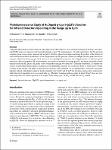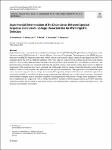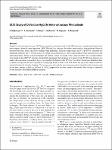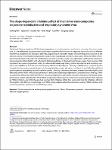Search
Author
- Manyk, T. (3)
- Murawski, K. (3)
- Baumgartner, Jörg (2)
- Guizani, Chamseddine (2)
- next >
Subject
Has File(s)
- true (187)
Search Results
The significance of waterlogged archaeological wood (WAW) lies in its profound informational value, encompassing historical, cultural, artistic, and scientific aspects of human civilization, and therefore need to be properly studied and preserved. In this study, the utilization of near-infrared (NIR) spectroscopy is employed as a predictive tool for assessing the hardness value of WAW. Given the submerged burial conditions, waterlogged wooden heritage frequently undergo substantial degradation in their physical and mechanical properties. The mechanical properties of waterlogged wooden heritage are essential for evaluating their state of preservation and devising appropriate conservation and restoration strategies. However, conventional methods for testing mechanical properties are l... |
A HgCdTe photodiode grown by chemical vapor deposition (MOCVD) on a GaAs substrate operating in the long-wave infrared (LWIR) range was characterized using photoluminescence (PL) measurements. At high temperatures, the PL spectrum originates from a free-carrier emission and might be fitted by a theoretical expression being the product of the density of states and the Fermi–Dirac distribution. At low temperatures, the PL spectrum consists of multiple emission peaks that do not originate solely from the energy gap. Such spectra are not unambiguous to interpret due to the prominence of different optical transitions. Spectral response (SR) measurements were used to determine the energy gap (Eg) and extract the band-to-band transition from the PL spectra. PL peaks visible within the band... |
Experimental results are reported for a medium-wavelength infrared (MWIR) HgCdTe photodetector designed in a joint laboratory run by VIGO Photonics S.A. and the Military University of Technology. The parameters of the MWIR detectors fabricated with HgCdTe heterostructures were studied. Advances in the metal–organic chemical vapor deposition (MOCVD) technique enable the growth of HgCdTe epilayers with a wide range of composition and doping, used for uncooled infrared detectors. Device-quality HgCdTe heterostructures were deposited on 2-inch-diameter, low-cost (100) GaAs substrates. The heterostructures obtained were examined measuring the spectral response and current–voltage characteristics in different temperatures. |
Deep-level transient spectroscopy (DLTS) measurements were performed on HgCdTe heterostructure photodiode grown by metal-organic chemical vapor deposition (MOCVD) on GaAs substrate. In order to extract defects from individual layers of the heterostructure, three consecutive etchings were performed. In the first experiment, the N+/T/p/T/P+/n+ structure was chemically etched to the N+ bottom contact to obtain a mesa-type detector. Six localized defects were extracted across the entire photodiode. In the second experiment, the bottom contact was made to the p-type absorber. Two localized defects were found in the p/T/P+/n+ structure. |
This paper presents the performance of an interband cascade long-wavelength infrared detector designed for high operating temperatures supported by immersion lenses. The device is based on the “Ga-free” InAs/InAsSb type-II superlattice with highly doped p+/n+ superlattice tunneling junctions connecting adjacent stages. Detectivity of the multi-junction heterostructure detector exceeding 1010 cm Hz1/2/W was estimated at wavelength λ ~ 9 µm and T = 210 K and ~ 3 × 108 cm Hz1/2/W for T = 300 K, achieving a tenfold improvement in detectivity in comparison to a device without an immersion lens and 30-fold improvement in detectivity in comparison to the single-stage device. |
Traditional Chinese medicines (TCMs)/nanopreparations as viral antagonists exhibited a structure–function correlation, i.e., the differences in surface area/volume ratio caused by the variations in shape and size could result in different biochemical properties and biological activities, suggesting an important impact of morphology and structure on the antiviral activity of TCM-based nanoparticles. However, few studies paid attention to this aspect. Here, the effect of TCM-based nanoparticles with different morphologies on their antiviral activity was explored by synthesizing rhein/silver nanocomposites (Rhe@AgNPs) with spherical (S-Rhe/Ag) and linear (L-Rhe/Ag) morphologies, using rhein (an active TCM ingredient) as a reducing agent and taking its self-assembly advantage. Using por... |
This article was updated to correct the spelling of Chinwendu Umeojiakor's name in the author list. |







